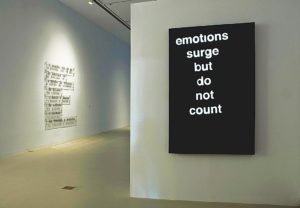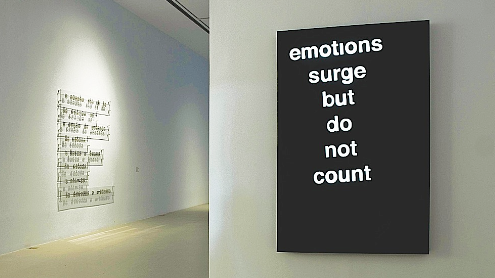Jasmine Saroya
Contributor
The image of a hand may be two-dimensional on the surface, something not worth a second glance. But for the Raqs Media Collective, an art group based out of New Delhi, this one image is enough to “anchor” an exhibition.

Currently displayed at the AGYU and scheduled to run until December 4, the exhibition is named Surjection after the mathematical concept. By juxtaposing the hand with the idea of weights, measures, change, time, infinity, history, and failures in communication, among many others, the exhibition manifests surjection: the application, transposition, and mapping of elements of a certain set onto those of another set.
For surjection to occur, something must begin to have its elements manipulated. In this exhibition, this introductory set is the installation, “Re-writing on the Wall”, which brings to mind a popular figure of speech.
“When you say the writing is on the wall, it is like saying that something bad is impending,” says Allyson Adley, collections and education assistant at the Art Gallery of York University. “It actually goes back to a biblical story in the Book of Daniel, where the prince Belshazzar is faced with hand-writing on a wall, and calls the Israelite Daniel for help. Daniel tells him that the words have to do with a weighing and measuring of his actions, and that he will face retribution.”
Adley tips us off that the theme of weights and measures begins here, and that it has modern extensions.
“There is also a contemporary idea of impending crisis or loss of power,” she says. The parallels are eerie when one considers the power struggle occurring in the Middle East, and how it resembles, in a way, the Biblical story Adley mentioned. Such parallels illustrate the idea of “asynchronous contemporaneity” that Adley defines as being “the relationship between different historical periods and places.”
We see this contemporaneity again in “Untold Intimacy of Digits”, a video projection of the handprint of Raj Konai, which was archived as a historical relic used to bind an agreement made between Konai and Sir William Herschel during the British occupation of India. Eventually, this handprint led to the breakthrough of forensics, and in turn, to India pursuing the creation of the world’s largest identification database, containing both handprints and iris scans.
Adley finds the contemporaneity when considering that “the work of Francis Galton in eugenics, in wanting to document people, is linked to the idea of contemporary biometrics, wanting to document people with an identification system. Historically, there is a precedent of wanting to document people, of wanting to find an average.”
Raqs chooses “Untold Intimacy” as a memorial symbol for the failure of India’s identification project. What interests Raqs, as critics of modernity, is the mistake of measuring or quantifying what are, by nature, immeasurable things, like our emotions, or the time we are given.
This failure lies at the centre of this exhibition, depicted in the hand of Raj Konai counting to infinity in perpetual motion, or in the “writing on the wall” that warns of immeasurable consequences, or when, in “36 Planes of Emotion”, it uses a collection of laser-engraved acrylic to place opposing collective nouns together, showing the opposition that exists in everything we feel.
“We isolate these emotions in a way that’s actually not true to how we experience them,” says Adley, “The Raqs talk about the idea of how when we experience one emotion, we are generally experiencing several things at once, so that the emotions are intersecting.”
By synthesizing philosophical, sociopolitical, and historical inquiry, the work of the Raqs “raises more questions than it answers,” according to Adley. However, she also notes that this is the case for much of contemporary art. She touts the exhibition’s far-reaching relevance.
“Our exhibition is relevant to people studying all different kinds of disciplines, from forensics to geography to mathematics to history,” says Adley.
The Raqs thus manage to send a very universal message, an interdisciplinary approach to counting, weighing, measuring, and quantifying those parts of our lives perhaps best left to be explored by art.


